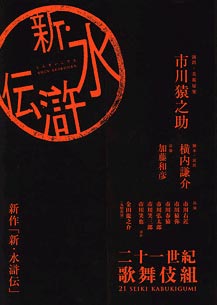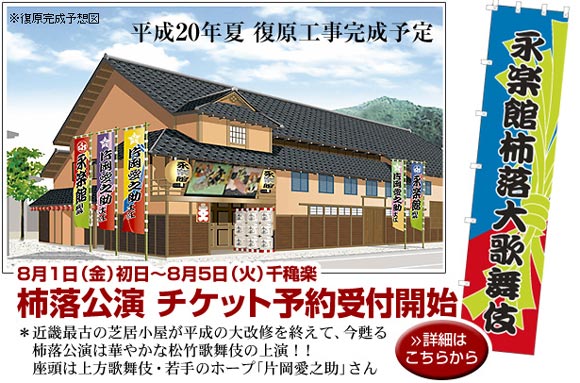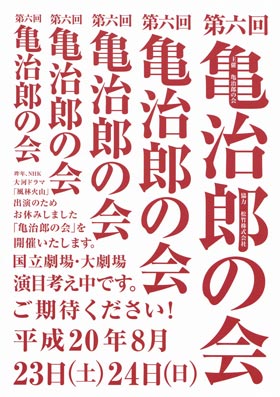| Comments |
19th edition of Nakamura Kanzabur˘'s summer program at the Kabukiza,
the Hachigatsu N˘ry˘ Kabuki (literally "the August cool-breeze Kabuki"),
which features a group of popular young stars headed by Nakamura Kanzabur˘ in three short programs of Kabuki,
perfect to fight the heat of summer. The program is very adventurous; featuring new plays, revivals of rarely performed modern plays and closing
with a Kabuki style version of the opera Aida by Noda Hideki, one of Japan's most famous contemporary directors.
Onna Shibaraku: more ceremony than play, "Shibaraku"
is one of the oldest pieces in Kabuki. Just as an evil villain is about to execute
a group of loyal retainers, a voice calls out for him to wait and a hero
appears to save the day. This version is a parody, though, as the hero
is played by an onnagata
female role specialist, who mixes the super-human strength of an
aragoto
hero with the soft gentleness of a Kabuki heroine. Featuring Nakamura Fukusuke as
the heroine and Band˘ Mitsugor˘ as the larger-than-life villain,
with Nakamura Kanzabur˘ as a friendly stage attendant who makes sure that
everything goes right.
Sannin Renjishi: "Renjishi" is one of the
most popular dances in Kabuki, but usually, it is a dance with father and son,
in this special version, mother and father appear along with the child.
In Asian tradition, the shishi is not
really a lion, but a kind of mythical creature that guards the mythical stone bridge
to heaven. There is also a tradition that the way a parent shishi teaches
its child is very severe and in this dance, the father lion throws his son into a
valley, hoping that he will have the strength to climb back up on his own.
The striving of the young cub, the concern of the parents, their joyous dance
when the son returns to the top of the mountain all show the love between father
and son. It stars Nakamura Hashinosuke as the father shishi,
with Nakamura Senjaku as the mother and Nakamura Kunio, in real life Nakamura Hashinosuke's son, as the child.
Rakuda: this is a popular dramatization of a rakugo comic
story. A petty gang boss named Rakuda (Kataoka Kamez˘) has died after eating blowfish.
Hanji (Band˘ Mitsugor˘), one of his gang members, finds him and hopes to bury him,
but has no money. When he tries to get the neighbors to contribute,
everyone is overjoyed that such a nuisance is dead, but won't contribute a
cent towards his burial. Finally Hanji pulls in a passing waste paper collector
named Kyűroku (Nakamura Kanzabur˘) and forces him to carry around Rakuda's body and
threaten to make it dance if the neighbors won't pay up.
They get a great sum of money and start drinking together.
But as he drinks, the hapless Kyűroku becomes surprisingly aggressive.
Tsubakuro-ha Kaeru:
(Yasunosuke's Search for a Home)
This is a rare performance of a modern play. A carpenter named
Bungor˘ (Band˘ Mitsugor˘) is on his way to Ky˘to when he gets a strange request.
A little boy named Yasunosuke was left by his mother in a foster home,
but was treated so badly that he ran away. He has heard that his mother is in Ky˘to
and begs Bungor˘ to take him with him. Reluctantly Bungor˘ agrees,
but during the long journey together, he almost becomes a second father to the boy.
In Ky˘to, he meets Yasunosuke's mother Kimika (Nakamura Fukusuke),
who is a geisha, but she tells him of her own hardships and that she
cannot see Yasunosuke. The play shows the heartbreaking dilemma of the
little boy caught between a mother that cannot keep him and the stranger
who has become a father to him.
ďeyama:
(The Demon of Mt. ďe)
One of the most famous stories about demons is about Shuten D˘ji,
the demon of Mt. ďe, who loved sake and
terrorized Ky˘to by kidnapping beautiful women and forcing them to serve him
before he ate them. Finally, he is defeated by the famous demon-quelling
warrior Minamoto no Raik˘ and his four followers.
Starring Nakamura Kanzabur˘ as Shuten D˘ji and Nakamura Senjaku as Raik˘.
Based on a classical N˘ play, this is a dance that was created by Nakamura Kanzabur˘ XVII
and will be presented by his son, the current Nakamura Kanzabur˘ for the first time.
Also featuring Nakamura Fukusuke, Nakamura Hashinosuke,
Band˘ Yajűr˘, Nakamura Kantar˘, Nakamura Shichinosuke,
Band˘ Shingo and Band˘ Minosuke.
Momijigari: the general Taira Koremochi (Nakamura Hashinosuke) travels to the mountains to view the
autumn leaves when he suddenly encounters a beautiful princess (Nakamura Kantar˘) and her entourage.
Aided by the elegant dancing of the princess and a large amount of sake, Koremochi falls asleep,
not knowing that she is actually a fierce demon. The god of the mountain (Band˘ Minosuke)
dances vigorously to try to wake up Koremochi. But as the demon appears in its true form,
Koremochi is saved by the magical power of his sword.
Aida Hime: this is a retelling of Verdi's opera "Aida" as a Kabuki
history play directed by Noda Hideki, who is famous for his colorful staging and
fast and funny movement and dialogue. All the characters of the original have
been transformed into Kabuki characters: Aida becomes Princess Aida,
Radames becomes Kimura Damesukezaemon, Amneris becomes Princess N˘.
It is the age of the warring states and a battle between the Owari and Mino domains
has ended in victory for the Mino domain and the defeated lord
Oda Nobuhide (Band˘ Mitsugor˘) has been forced to send his beautiful daughter Princess Aida
(Nakamura Shichinosuke) as a hostage to victorious Sait˘ D˘san (Band˘ Yajűr˘) and she is forced to become maid
to his daughter Princess N˘ (Nakamura Kanzabur˘). D˘san wants his daughter to marry
Kimura Damesukezaemon (Nakamura Hashinosuke), the most powerful of his generals,
but Damesukezaemon is in love with Aida. When she learns of this, Princess N˘
is filled with jealousy and at the same time, Aidaĺs father Nobuhide plots
his revenge on the Mino clan.
Source: Earphone Guide website
|




